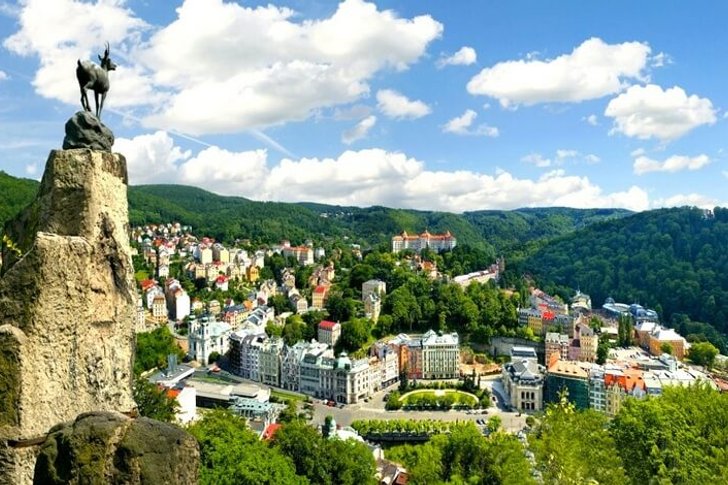A trip to the quiet and peaceful Karlovy Vary is a real rest for the soul and a healing balm for the body. For Russian tourists, this Czech resort has become "native" since tsarist times. From time immemorial, aristocrats and intellectuals rushed here for treatment.
Today Karlovy Vary is a worthy balneological tradition, excellent service of comfortable hotels and, of course, numerous hot springs that can improve health and cure numerous ailments. Local sanatoriums offer various health programs for every taste.
Also, the urban neighborhoods are of great interest. There are medieval castles, picturesque canyons on the wooded slopes of the river and numerous equipped trails to contemplate all this splendor.
What to see and where to go in Karlovy Vary?
The most interesting and beautiful places for walking. Photos and a short description.
- Mineral springs
- Lookout tower Diana
- Goethe lookout tower
- Castle tower
- Geyser colonnade
- Mill colonnade
- Market Colonnade
- Garden colonnade
- Castle colonnade
- Church of St. Mary Magdalene
- Peter and Paul Church
- Jan Becher Museum
- Karlovy Vary Regional Museum
- Moser Glass Museum
- Karlovy Vary Art Gallery
- Karlovy Vary City Theater
- Outdoor pool of the hotel Termal
- Grand Hotel Pupp
- Imperial Hotel
- Loket Castle
- Walech Castle
- Bečov nad Teploy
- Dvorak Gardens
- Svatosh rocks
- Rock Deer Leap
Mineral springs
There are about 70 mineral springs in Karlovy Vary, but only 12 are considered to have healing properties. Each is designed to treat and prevent a specific group of diseases. The water temperature ranges from 30°C to 70°C. Picturesque colonnades were erected around the thermal springs in the 19th-20th centuries, which protected them from the effects of the external environment.

Lookout tower Diana
The tower is located on the top of Druzhba hill. Tourists can get there by funicular, or spend half an hour and walk along the hiking trail. From the observation deck of the tower, you can enjoy a panoramic view of the forested green hills that surround Karlovy Vary. In addition to the tower itself, there is a cafe, a restaurant on the hill, as well as benches and comfortable places to relax.
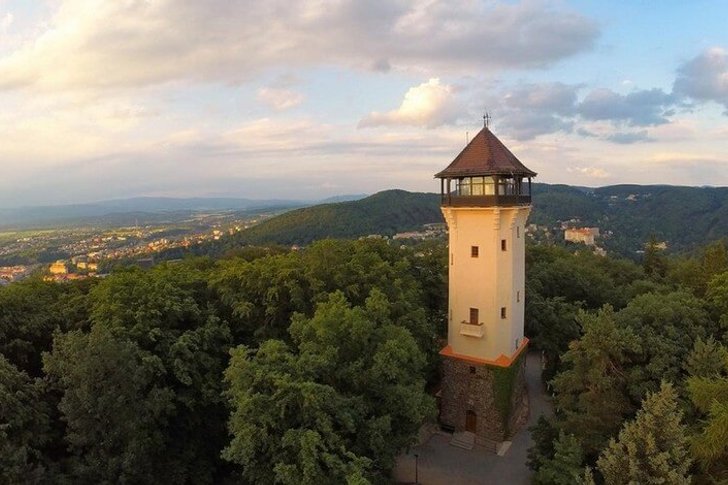
Goethe lookout tower
The building was erected at the end of the 19th century; it is the oldest observation deck in Karlovy Vary. It is interesting that in 1945 the tower was named after I. Stalin, but already in the 60s. renamed. A staircase consisting of 165 steps (42 meters high) leads to the top of the building. Many objects of the Goethe Tower were restored only in 2002 with the active participation of F. Gaspra, who wanted to make the appearance of Karlovy Vary more attractive.
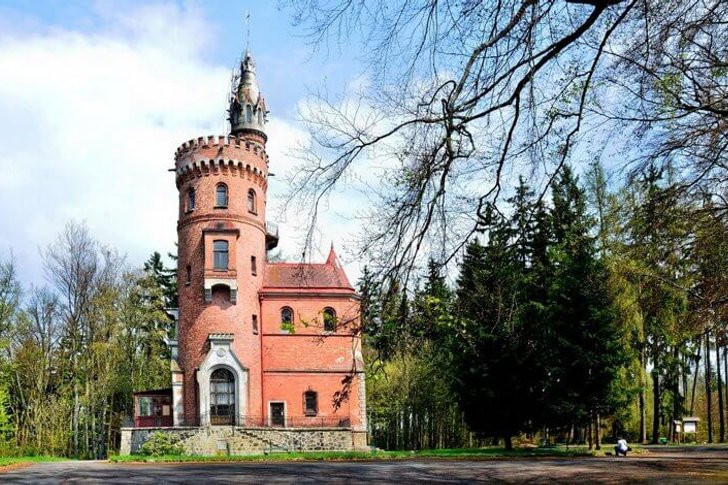
castle tower
An elegant castle built under the reign of Charles IV. Initially, it was assumed that the building would be used as a hunting lodge, but after the construction was completed, the local aristocracy began to organize holidays, balls and lavish receptions here. In 1604 the castle was destroyed by fire, but soon a new tower was erected. The building of the 17th century has survived to this day. Now there is a restaurant on the territory of the Castle Tower.
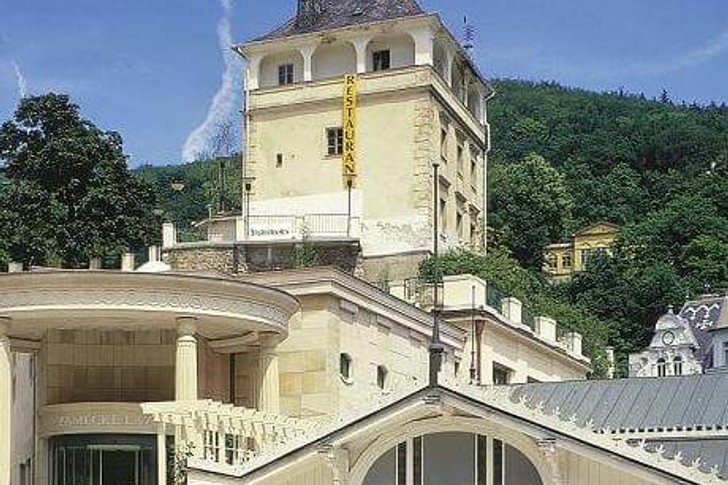
Geyser colonnade
Glass building built in the 1970s. XX century according to the project of Ya. Otrub. The colonnade is located near the Vrzhidlo spring, which bursts out of the ground with a powerful hot stream (2 thousand liters of water / min.). Due to the high temperature, it is impossible to stay near the geyser for a long time. In the colonnade, in addition to the hall with the source, there is an extensive hall where souvenirs, dishes and Bohemian glass are sold.

mill colonnade
A picturesque colonnade built in the 19th century in the Neo-Renaissance style with elements of an elegant Empire style. It consists of 124 monumental columns supporting the facade with bas-reliefs by V. Lokvents. Inside the Mill Colonnade there are mineral springs “Prince Vaclav”, “Melnichny”, “Rusalka”, “Libuše” and “Rocky”. The water temperature in the springs ranges from 45°C to 64°C.
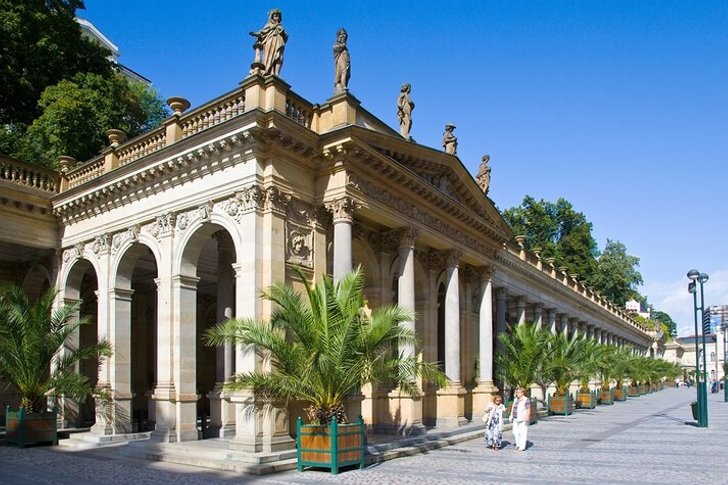
Market Colonnade
The structure was erected in 1883 of wood and was supposed to last only a few years before the construction of something more imposing. But it lasted over 100 years. At the end of the 20th century, the city authorities decided on a complete reconstruction, and now tourists have the opportunity to admire the restored landmark. Inside there are two sources - "Market" and "Karl IV". Immediately behind the Market Colonnade is the Castle Tower.
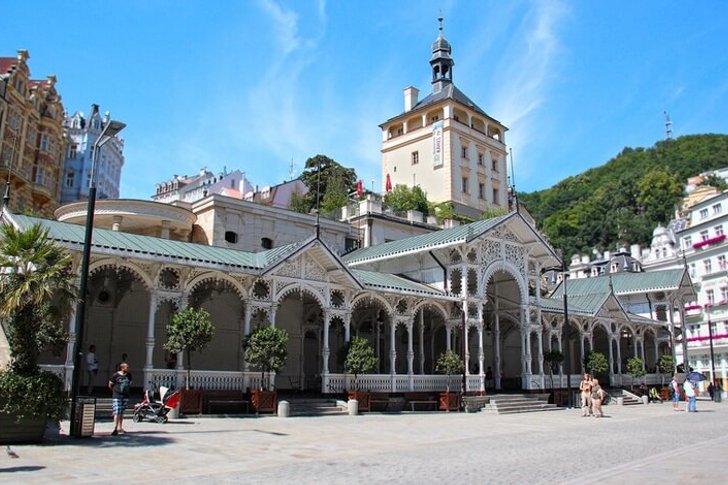
garden colonnade
The colonnade was erected in 1880 according to the project of G. Gelmer and F. Felner. These two architects made a great contribution to the appearance of Karlovy Vary. In the middle of the 20th century, the pavilion was dismantled and only a frame with columns remained from the building. However, in 2002 the historical appearance was restored. Now the Garden Colonnade is a real decoration of the city. Inside are the springs "Snake" and "Garden".
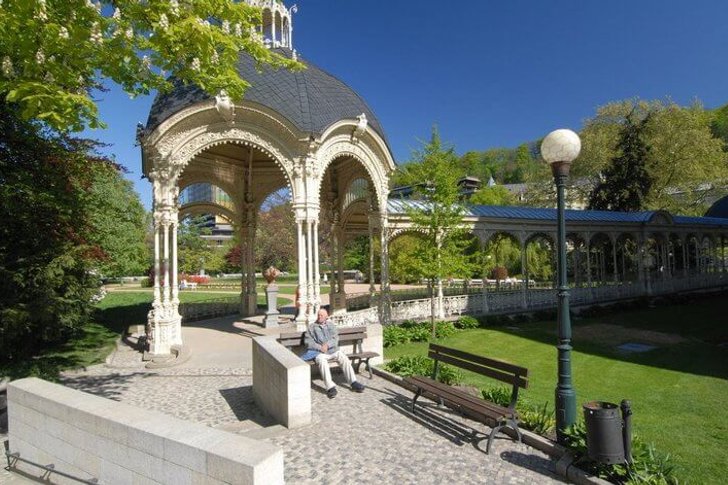
castle colonnade
An architectural building in the Art Nouveau style, erected at the beginning of the 20th century according to the design of the Viennese architect F. Oman. At the beginning of the 21st century, the colonnade was renovated at the expense of the Zamkovy Lazne hospital, which made many facilities available only to the clients of this institution. Everyone can drink the healing water from the spring, but admiring the magnificent interior decoration of the Castle Colonnade is available only to tourists living in the Castle Lazne.

Church of St. Mary Magdalene
Temple of the 18th-19th centuries, designed by K. Dientzenhofer. The first church in the Gothic style appeared on this site in the 15th century, it belonged to the order of the Crusaders. Later, the building was rebuilt in a more fashionable and progressive Renaissance style at that time. Subsequently, the temple was repeatedly destroyed during wars and fires, as a result, by the 18th century the building was almost destroyed. The restoration was completed by 1861.
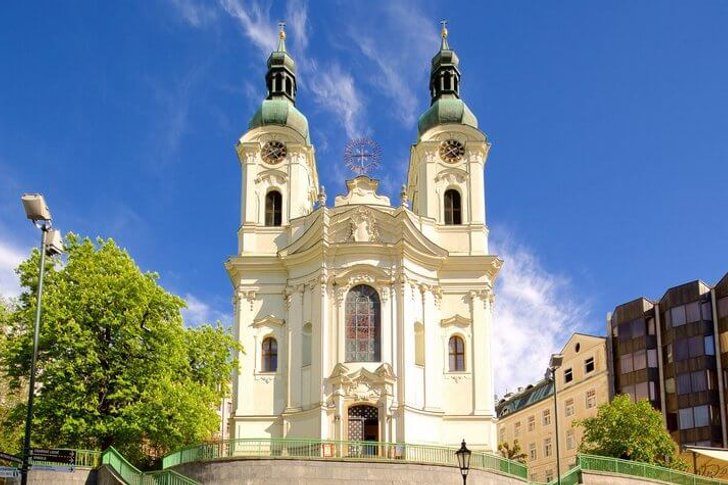
Peter and Paul Church
The current Orthodox church, built in the 19th century according to the project of D. Ukhtomsky. It was the first Orthodox church on the territory of the Austrian Empire. Due to the war, the church was closed in 1916, services resumed only in the middle of the 20th century. A complete renovation took place in the 1980s. Since then, the building has been maintained in excellent condition thanks to the efforts of the local authorities.
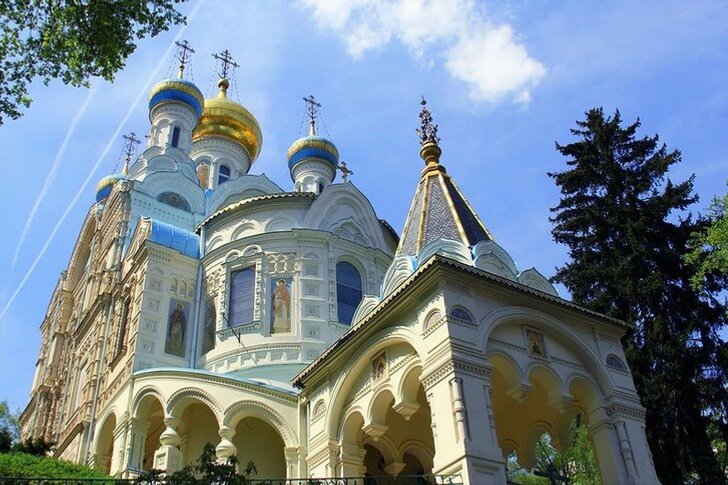
Jan Becher Museum
The famous drink "Becherovka" in the Czech Republic is revered and loved, sometimes it is even called the "thirteenth source" of Karlovy Vary. It is used as a medicine and an ingredient in many cocktails. The company for the production of "Becherovka" was founded by a local pharmacist Jan Becher. The museum named after him was opened in Karlovy Vary in 1992. During the tour, visitors can taste a drink with different flavors, learn about its history and buy souvenirs.

Karlovy Vary Regional Museum
The museum complex includes three buildings, since a smaller number was not enough to accommodate an extensive exposition. Archaeological finds, objects of art and everyday life, documents, geological exhibits related to the history of Karlovy Vary are exhibited here. The museum was founded in 1865 on the initiative of the Austrian doctor and expert in the field of balneology J.V. von Loeschner.
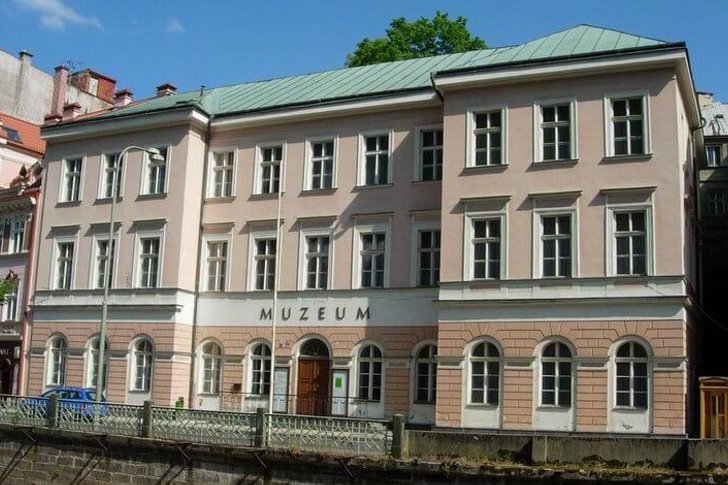
Moser Glass Museum
The Moser glassworks was built in Karlovy Vary in 1875. He is engaged in the production of products from Bohemian glass - a famous brand that has become famous throughout the world due to its high quality. In the factory museum, you can see an exposition made up of the most valuable and rare specimens produced at different times on Moser. You can also get acquainted with all stages of glass production.

Karlovy Vary Art Gallery
The museum exhibits contemporary works of art created by Czech sculptors and artists in the second half of the 20th century. The permanent exhibition contains about 150 works in the style of cubism, expressionism and fauvism. Temporary exhibitions are often held on the territory of the gallery, as well as performances and concerts. The building was built in 1912 in neoclassical style.
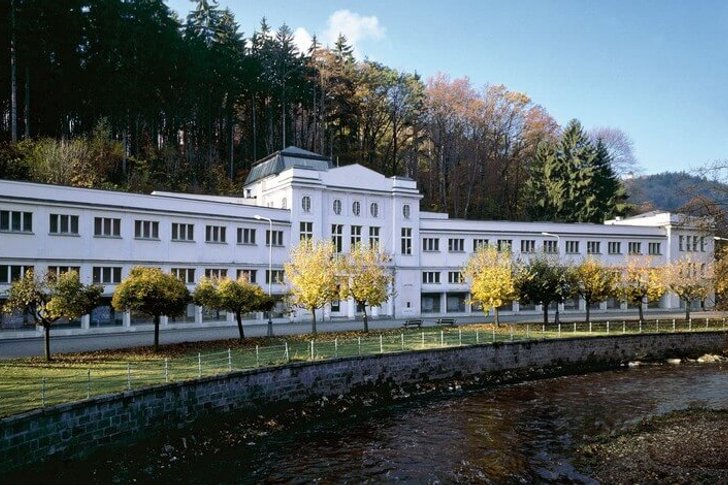
Karlovy Vary City Theater
The theater building was built in the 19th century according to the design of G. Gelmer and F. Felner. Previously, there was a wooden building in its place, which collapsed during a fire in 1787. The inspirer to raise funds for the construction of the theater was one of the founders of balneology in Karlovy Vary - D. Becher. The wonderful enchanting opera by W. A. Mozart "The Marriage of Figaro" was played as a premiere performance.

Outdoor pool of the hotel "Termal"
Heated swimming pool, open at any time of the year, which is located on the territory of the hotel "Termal". The water in it is not medicinal, but the most ordinary, so everyone can swim. The pool has a fitness club, sauna, solarium and massage room. The length of the pool from side to side is 50 meters, the depth is up to 4.5 meters. The pool offers a magnificent view of the buildings of the surrounding hotels and the surrounding hills. The pool is not open at this time.

Grand Hotel Pupp
The sanatorium is located in a building from the beginning of the 18th century, which is one of the most picturesque architectural structures in Karlovy Vary. Famous musicians, royalty, representatives of aristocratic families, cultural figures and other famous people have been guests of the Pupp Hotel. Every year, the hotel hosts an international film festival, which attracts world-class stars.
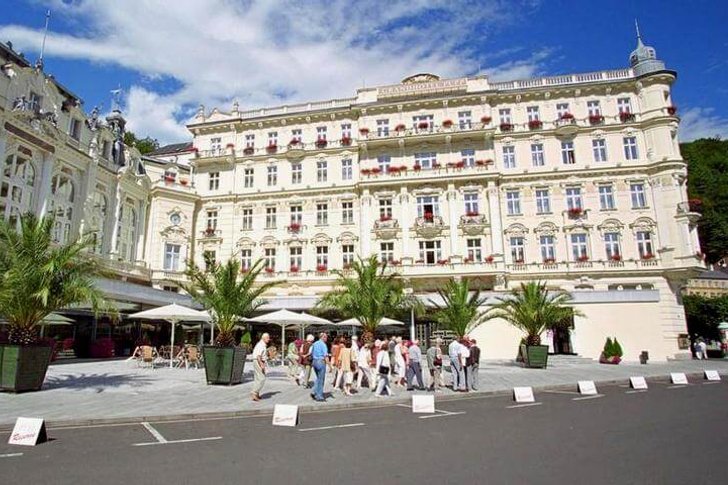
Imperial Hotel
A four-star hotel built in the classical style at the beginning of the 20th century. The hotel is surrounded by a magnificent park with its own theater stage. The interior of the "Imperial" is dominated by discreet luxury and calm notes of Art Nouveau style. There is also a cinema, a concert hall and spacious auditoriums for seminars. The hotel's resort restaurant serves national and international cuisine, and you can also choose from 9 diet menu options.

Loket Castle
The castle is located near Karlovy Vary. There is controversy over the date of its foundation, but experts point to the 13th century. The building is a harsh medieval fortress with thick walls and narrow loopholes. Presumably, Loket was built as a border fort, which demarcated the German and Czech possessions. The castle rises on the bank of the Ohře river.
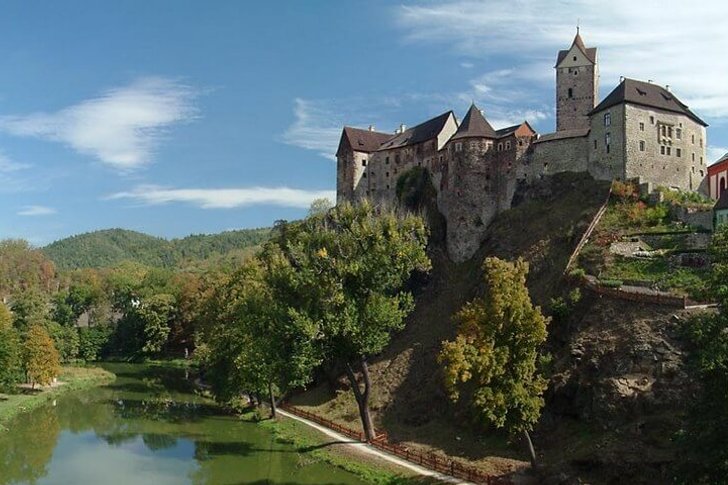
Walech Castle
An architectural structure of the 16th century, erected during the reign of Vladislav II. The castle changed owners many times. The greatest flourishing occurred in the period 1695 - 1733. The castle park was created under the influence of the traditions of Italian landscape design. The church, built in the 18th century according to the project of Giovanni Ross, deserves special attention. The last owner of Valech was Count Larisch-Mennich, then the property was transferred to the state.

Bečov nad Teploy
A Czech baroque castle located on a rocky bank of the Teplá River. It is believed that the building was erected in the XIII century. Over the next two centuries, the castle was owned by different families, until it was captured by the Swedes during the Thirty Years' War. Major reconstructions were carried out in the second half of the 17th century and in the 19th century. Bečov nad Teploi became state property in 1945.

Dvorak Gardens
A picturesque city park, which was created at the end of the 19th century. Trees over 200 years old grow on its territory. The gardens were named after the Czech composer A. Dvořák; the maestro's monument adorns one of the alleys of the park. It should be noted that visitors are allowed not only to walk gracefully along the paths and sit on the benches, but also to walk on the lawns, which makes the park attractive to most residents and guests of Karlovy Vary.
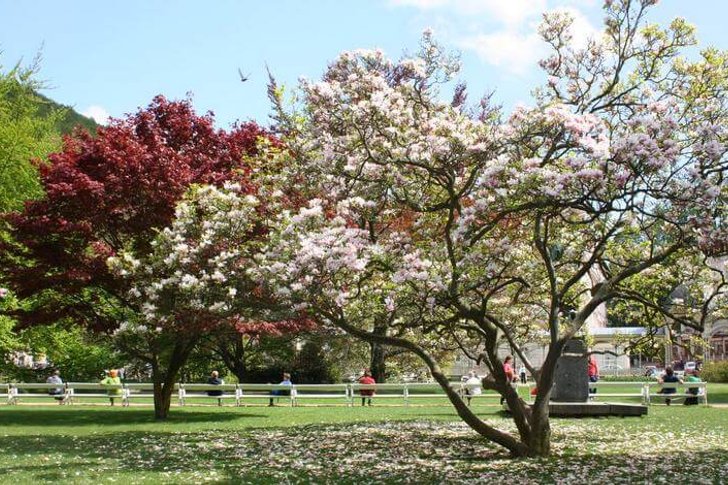
Svatosh rocks
A picturesque canyon in the Ohře river valley, where you can admire the natural beauties of the surroundings of Karlovy Vary. This natural site is included in the list of specially protected areas in the Czech Republic. Many legends are associated with the Svatoshki rocks. At one time, they inspired the brothers Grimm, Goethe, Kerner and Spiess to create poetic literary works.
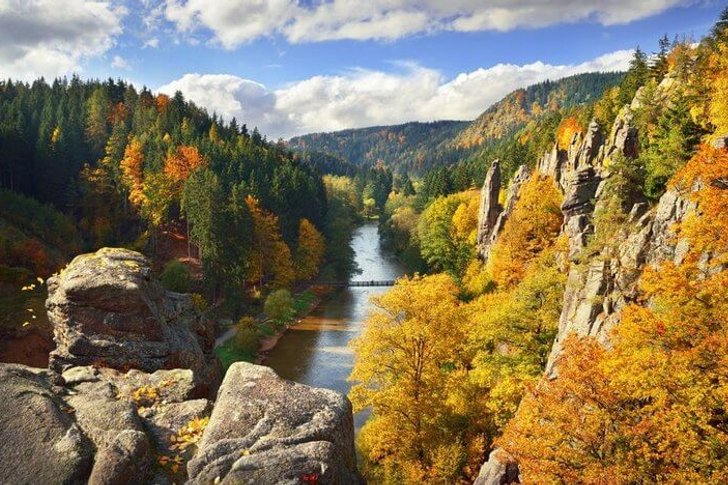
Rock "Deer Leap"
A low rock, on top of which a statue of a chamois was placed in 1851. The metal sculpture was created by August Kiss. Unfortunately, in 1984 the figure was destroyed by vandals. Two years later, the sculptor J. Kotek created a bronze copy, which now crowns the top of the hill. "Reindeer lope" is one of the symbols of Karlovy Vary. Near the statue there is an observation deck, very popular with tourists.
